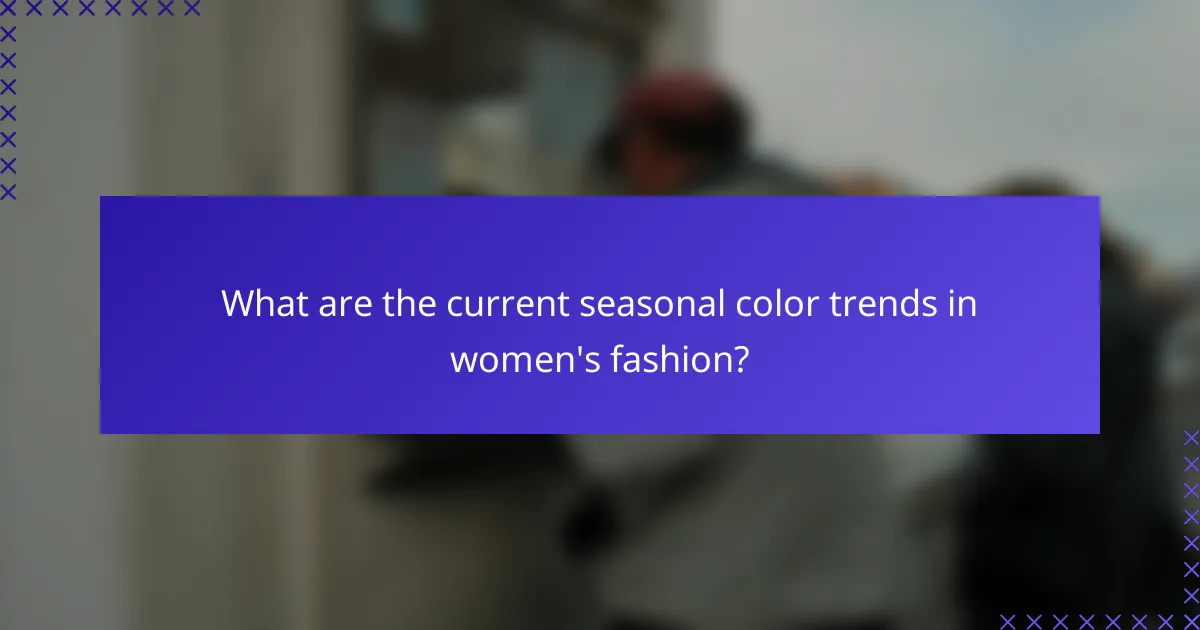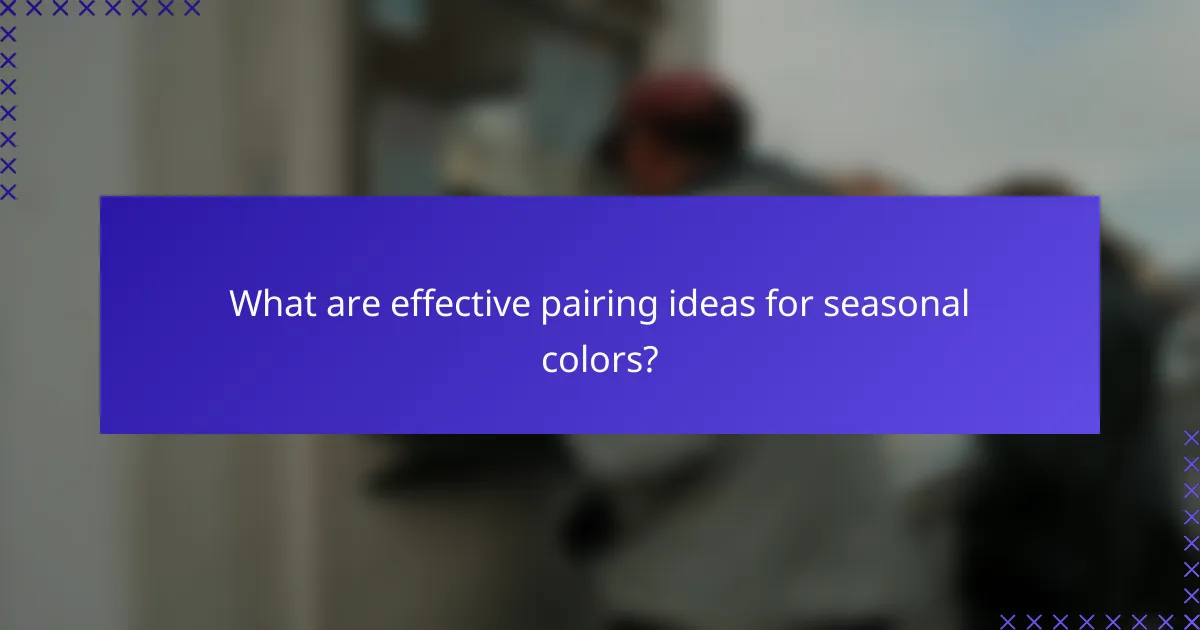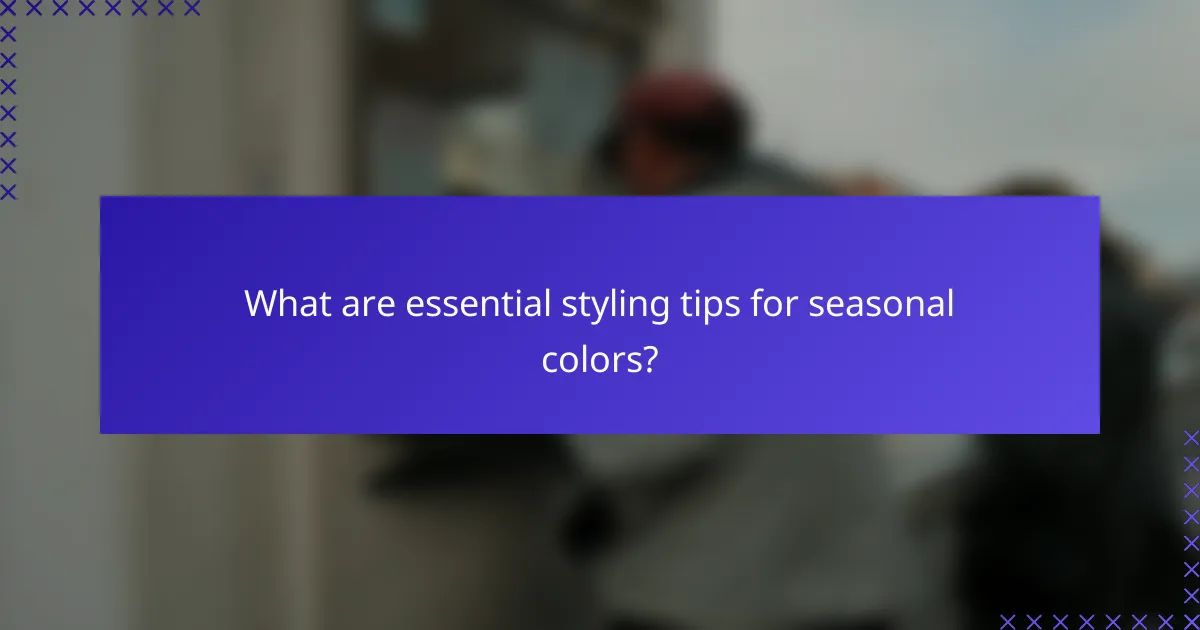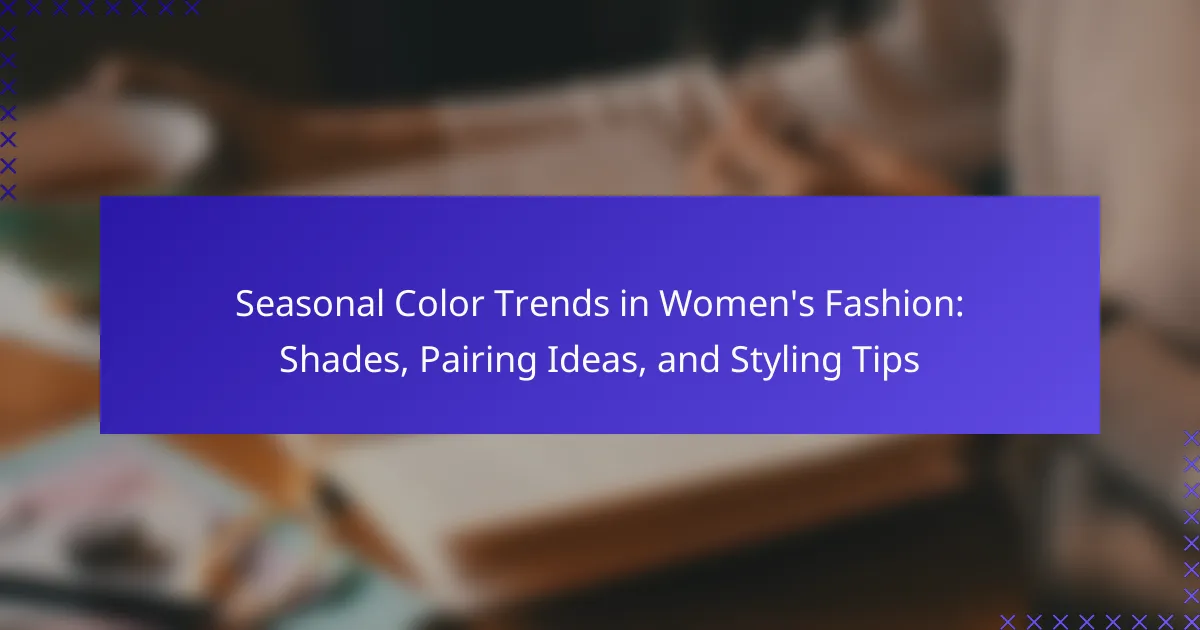Seasonal color trends in women’s fashion are defined by earthy tones, pastels, and vibrant jewel shades. Key colors this season include terracotta, olive green, soft lavender, and emerald, reflecting a growing preference for nature-inspired palettes. The article explores effective pairing ideas, such as mixing warm and cool tones, and offers essential styling tips tailored to different seasons. Readers will gain insights into how to choose colors that complement their skin tone and how to incorporate seasonal shades into their outfits for a balanced and stylish look.

What are the current seasonal color trends in women’s fashion?
Current seasonal color trends in women’s fashion include earthy tones, pastels, and vibrant jewel shades. Earthy tones like terracotta, olive green, and mustard yellow are popular this season. Pastels such as soft lavender, mint green, and pale pink are also trending. Vibrant jewel shades like emerald, sapphire, and ruby are making a statement in various collections. These colors reflect a shift towards nature-inspired palettes. Fashion weeks and designer collections showcase these trends prominently. Influencers and fashion retailers are adopting these colors in their seasonal offerings. This aligns with consumer preferences for comfort and connection to nature.
How do seasonal color trends influence women’s fashion choices?
Seasonal color trends significantly influence women’s fashion choices by dictating the hues that are popular in a given season. These trends emerge from fashion weeks, industry forecasts, and cultural influences. For example, Pantone releases a Color of the Year that shapes consumer preferences. In spring, lighter pastels often dominate, while autumn may favor deeper, richer tones. Women tend to select clothing that aligns with these trends to stay fashionable. Retailers also stock items in trending colors, making them more accessible. This alignment between trends and consumer choices drives sales and shapes overall fashion markets.
What are the key colors for this season?
The key colors for this season include deep emerald green, soft pastels, and warm earth tones. Deep emerald green represents luxury and sophistication. Soft pastels, such as lavender and blush, evoke a sense of calm and freshness. Warm earth tones like terracotta and mustard reflect a connection to nature. These colors align with current fashion trends observed in major runway shows. Fashion designers have incorporated these shades into their collections for the season. Color forecasting agencies, such as Pantone, have highlighted these hues as essential for this time of year.
How do these colors reflect current fashion movements?
Current fashion movements are significantly influenced by color trends. Seasonal colors often represent cultural, social, and economic sentiments. For instance, vibrant colors may reflect a desire for optimism and joy during challenging times. Pastel shades can symbolize a return to softness and comfort in design.
The 2023 Pantone Color of the Year, Viva Magenta, showcases a bold, empowering tone that aligns with the growing emphasis on individuality in fashion. Additionally, earthy tones have surged in popularity, mirroring a collective shift towards sustainability and nature-inspired aesthetics.
Fashion weeks globally highlight these color trends, demonstrating their relevance through designer collections. The use of color in fashion serves as a visual language that communicates broader societal themes and movements.
Why is understanding seasonal color trends important for styling?
Understanding seasonal color trends is important for styling because it influences fashion choices and enhances personal expression. Seasonal colors reflect current trends and consumer preferences. By aligning outfits with these colors, individuals can appear more fashionable and relevant. Additionally, using seasonal colors can boost confidence and create a cohesive look. Studies show that colors can affect mood and perception, making the right choice essential for styling. For example, spring often features pastels, while autumn leans towards earthy tones. This alignment helps in making informed purchasing decisions and enhances overall style impact.
How can seasonal color trends enhance personal style?
Seasonal color trends can enhance personal style by providing a fresh palette that aligns with current fashion aesthetics. These trends allow individuals to express their personality and mood through color choices. For example, spring often features pastels, which convey a sense of renewal and lightness. In contrast, autumn may emphasize rich, warm tones that evoke comfort and coziness.
Utilizing seasonal colors can also improve wardrobe versatility. By incorporating trending shades, outfits can feel more modern and relevant. Additionally, wearing colors that complement one’s skin tone can enhance overall appearance and confidence. A study by the Color Marketing Group shows that color influences perception and emotional response, supporting the idea that seasonal colors can positively impact personal style.
What role do seasonal color trends play in wardrobe planning?
Seasonal color trends significantly influence wardrobe planning by guiding choices in clothing and accessories. These trends help individuals select colors that are currently fashionable, ensuring their outfits are stylish and relevant. Seasonal colors can enhance personal style and boost confidence. For instance, colors like pastels are often favored in spring, while rich, warm tones are popular in fall. Following these trends can also improve versatility in mixing and matching items. Fashion experts often analyze runway shows and style forecasts to identify these trends. This analysis provides insight into what colors will dominate each season. By incorporating seasonal colors, individuals can create cohesive and updated wardrobes.

What are some popular shades for this season?
Popular shades for this season include earthy tones, vibrant jewel tones, and soft pastels. Earthy tones such as terracotta and olive green are trending. Vibrant jewel tones like emerald and sapphire add richness to outfits. Soft pastels, including lavender and blush, provide a fresh, light feel. These shades reflect current fashion trends seen in major fashion weeks. Designers are embracing a mix of bold and subtle colors. The combination of these shades allows for versatile styling options. Fashion reports indicate these colors resonate well with seasonal themes.
How can different shades be incorporated into outfits?
Different shades can be incorporated into outfits by using color blocking, layering, and accessories. Color blocking involves pairing contrasting shades to create a bold look. Layering allows for the combination of different shades in various clothing pieces. Accessories such as scarves, bags, and shoes can introduce additional shades without overwhelming the outfit. Monochromatic outfits can also be created by using different shades of the same color for a cohesive appearance. According to color theory, complementary shades enhance visual interest and balance. Seasonal color trends influence which shades are popular, allowing for timely and stylish combinations.
What are the best ways to mix and match shades?
The best ways to mix and match shades include using a color wheel for guidance. Complementary colors, which are opposite each other on the wheel, create vibrant contrasts. Analogous colors, located next to each other, offer a harmonious look. Neutrals can balance bold shades, making them easier to wear. Monochromatic schemes use varying shades of a single color for a sophisticated effect. Testing combinations in natural light helps ensure they work well together. Seasonal trends also influence shade pairings, with warmer tones often favored in fall and cooler tones in spring.
How do different shades complement various skin tones?
Different shades can enhance or diminish the appearance of various skin tones. Warm skin tones typically complement earthy shades like orange, yellow, and warm reds. Cool skin tones, on the other hand, look best with jewel tones such as emerald, sapphire, and cool blues. Neutral skin tones can wear a wider range of colors, including both warm and cool shades.
Studies indicate that color theory plays a significant role in fashion. For instance, a study published in the Journal of Fashion Marketing and Management found that color choices can influence perceptions of attractiveness. This reinforces the importance of selecting shades that align with one’s skin tone.
What are the psychological effects of colors in fashion?
Colors in fashion significantly influence psychological responses. Different colors evoke various emotions and perceptions. For instance, red often symbolizes passion and energy. Blue is associated with calmness and stability. Yellow can evoke feelings of happiness and optimism. Green typically represents nature and tranquility. Black is often linked to sophistication and power. White conveys purity and simplicity. Studies show that color choices can affect mood and behavior, impacting how individuals are perceived by others. For example, wearing bright colors may enhance confidence and attract attention. Understanding these effects can guide individuals in making informed fashion choices that align with their desired emotional expression.
How do colors influence mood and perception in style?
Colors significantly influence mood and perception in style. Different colors evoke specific emotions and reactions. For instance, blue commonly promotes calmness and tranquility. Red often stimulates energy and passion. Yellow is associated with happiness and optimism. Green can create a sense of balance and harmony.
These emotional responses can affect how clothing is perceived. Research shows that color choices in fashion can impact first impressions. A study by the University of California found that people often associate colors with personality traits. For example, individuals wearing black are often perceived as more authoritative.
Additionally, colors can influence consumer behavior. A study published in the Journal of Experimental Psychology indicated that color can affect purchasing decisions. Warm colors tend to attract attention, while cool colors can create a sense of trust.
In summary, colors play a crucial role in shaping mood and perception in style, impacting both emotional reactions and social judgments.
What colors are associated with confidence and empowerment?
Red, blue, and black are colors commonly associated with confidence and empowerment. Red signifies strength and passion. It is often linked to assertiveness and boldness. Blue represents trust and reliability. It evokes calmness and stability, which can empower individuals. Black conveys sophistication and authority. It is frequently associated with power and elegance. These colors have been used in various contexts, including fashion and branding, to evoke feelings of confidence.

What are effective pairing ideas for seasonal colors?
Effective pairing ideas for seasonal colors include combining warm hues with cool tones. For example, pairing deep burgundy with soft blush creates a balanced look. Another idea is to mix earthy tones like olive green with creamy whites. This combination enhances the natural feel of the outfit. Bright colors like coral can be paired with navy for a striking contrast. Additionally, pastel shades like lavender work well with light gray for a subtle elegance. These combinations are popular in fashion, reflecting current trends and seasonal palettes.
How can you create a balanced outfit using seasonal colors?
To create a balanced outfit using seasonal colors, start by selecting a primary color that aligns with the season. For example, spring often features pastels while autumn highlights warm earth tones. Next, choose complementary colors that enhance the primary shade. This can involve using colors from the same palette or contrasting shades to create visual interest. Incorporate neutral tones to ground the outfit and provide balance. For instance, pairing a bright color with beige or gray can soften the overall look. Additionally, consider the proportions of each color in your outfit. A good rule of thumb is to use the 60-30-10 rule, where 60% is the dominant color, 30% is the secondary color, and 10% is an accent color. This method ensures that no single color overwhelms the outfit. Finally, accessorize with seasonal colors to tie the look together. This approach not only creates harmony but also reflects the seasonal trends effectively.
What are some tips for pairing bold colors with neutrals?
Pair bold colors with neutrals by balancing intensity. Use neutrals as a backdrop to allow bold colors to stand out. Start with a neutral base, such as beige or gray. Then, add one or two bold accents, like a bright red or deep blue. This creates a focal point without overwhelming the space. Consider the color wheel for complementary colors. Pairing opposites can enhance visual interest. Use textures to add depth, mixing matte and shiny finishes. Finally, limit the number of bold colors to maintain harmony. This approach ensures a cohesive and stylish look.
How do patterns and prints interact with seasonal colors?
Patterns and prints interact with seasonal colors by enhancing visual appeal and creating contrast. Seasonal colors are often influenced by nature and trends, shifting with each season. Patterns can either complement or clash with these colors. For example, floral prints in spring align with pastel hues. In autumn, geometric patterns may harmonize with rich, warm tones. The right combination can elevate an outfit’s overall aesthetic. Color theory supports this interaction, as certain patterns can amplify or soften seasonal shades. Studies show that color combinations affect perceptions of style and mood.
What accessories work best with seasonal color trends?
Accessories that work best with seasonal color trends include scarves, handbags, and jewelry. Scarves can add a pop of color and complement the seasonal palette. Handbags in trending hues enhance the overall outfit aesthetic. Jewelry pieces, such as earrings and necklaces, can feature seasonal colors or materials. These accessories help to tie together an outfit while reflecting current color trends. For instance, during spring, pastel-colored accessories are popular. In autumn, warm tones like burgundy and mustard are favored. Seasonal color trends influence accessory choices significantly.
How can accessories enhance or clash with seasonal colors?
Accessories can enhance or clash with seasonal colors based on their color, texture, and style. When accessories complement the main seasonal palette, they can elevate an outfit’s overall aesthetic. For example, wearing gold jewelry with warm autumn tones enhances the richness of the colors. Conversely, accessories that contrast sharply with seasonal colors can create visual discord. A bright, neon handbag may clash with muted winter shades, drawing attention away from the outfit. Color theory supports this, indicating that complementary colors can create harmony, while contrasting colors can lead to dissonance. Therefore, careful selection of accessory colors and styles is crucial for achieving a cohesive look.
What are some must-have accessories for this season?
Must-have accessories for this season include oversized sunglasses, statement belts, and chunky jewelry. Oversized sunglasses provide both style and sun protection. Statement belts can elevate any outfit and define the waist. Chunky jewelry adds a bold touch to seasonal looks. These accessories align with current fashion trends emphasizing boldness and individuality. Fashion experts note that these items are frequently featured in runway shows this season. The popularity of these accessories is reflected in their presence in major retail stores.

What are essential styling tips for seasonal colors?
Essential styling tips for seasonal colors include choosing shades that complement your skin tone. For spring, opt for pastel colors like soft pinks and light blues. In summer, vibrant hues such as coral and turquoise work well. Autumn calls for earthy tones like rust and olive green. Winter styling benefits from deep colors like navy and burgundy. Pair seasonal colors with neutral tones for balance. Accessorizing with seasonal colors can enhance your overall look. Consider layering to incorporate multiple shades effectively. Understanding color theory can help in making harmonious choices.
How can layering be used to showcase seasonal colors?
Layering can effectively showcase seasonal colors by combining various garments in different hues. This technique allows for the display of multiple shades simultaneously. For instance, a light sweater can be layered over a darker shirt, creating contrast. Additionally, outerwear in seasonal colors can be added to enhance the overall look. Accessories like scarves or hats can introduce more colors without overwhelming the outfit. The strategic use of textures in layers can also highlight the vibrancy of seasonal shades. According to fashion experts, layering is a practical way to adapt to changing temperatures while maintaining style. This method encourages creativity in color pairing, enabling individuals to express their personal style.
What are the best layering techniques for different body types?
The best layering techniques for different body types include strategic choices that enhance proportions and create balance. For pear-shaped bodies, layering with longer cardigans or duster coats helps elongate the silhouette. Hourglass figures benefit from fitted tops under structured jackets to highlight the waist. Athletic body types can use layering with belted outerwear to create curves. For apple-shaped bodies, adding flowy layers can disguise the midsection while drawing attention to the legs. Each technique aims to enhance the body’s natural shape and create a flattering look. These methods are supported by fashion experts who emphasize the importance of tailoring layers to individual body shapes for optimal style.
How can you transition seasonal colors from day to night?
To transition seasonal colors from day to night, start by choosing versatile shades. Daytime looks can feature lighter, softer tones. For evening, deepen the colors or add richer hues. Incorporate accessories to enhance the transition. For example, swap daytime sandals for elegant heels. Layer with a chic jacket or wrap for a sophisticated touch. Use bold makeup to complement the evening look. This approach allows for a seamless shift while maintaining the seasonal color palette.
What common mistakes should be avoided when styling seasonal colors?
Common mistakes to avoid when styling seasonal colors include clashing colors, neglecting skin tone, and overcomplicating outfits. Clashing colors can create visual discord. It’s essential to choose complementary colors that enhance each other. Neglecting skin tone leads to unflattering choices. Identifying whether you have warm or cool undertones helps in selecting suitable shades. Overcomplicating outfits can detract from the overall look. Simple, cohesive styling often results in a more polished appearance. Additionally, ignoring current trends may make outfits feel outdated. Staying informed about seasonal color palettes ensures a fresh look.
How can you ensure your outfit looks cohesive and intentional?
To ensure your outfit looks cohesive and intentional, focus on color coordination and balance. Select a color palette that complements your skin tone and aligns with seasonal trends. Use three to five colors in your outfit to maintain harmony. Ensure that your accessories, shoes, and outerwear match or complement your chosen palette. Pay attention to patterns; mixing patterns can work if they share a common color. Aim for a balanced silhouette by combining fitted and loose pieces. Consider the occasion and dress accordingly to enhance intentionality. Research shows that cohesive outfits can improve confidence and social perception.
What are the pitfalls of overusing seasonal colors?
Overusing seasonal colors can lead to a lack of versatility in fashion choices. This can result in outfits that feel repetitive and uninspired. When seasonal colors dominate a wardrobe, it may limit personal expression. Additionally, overuse can make it challenging to transition between seasons smoothly. Fashion trends evolve, and sticking too rigidly to seasonal colors can make outfits feel outdated quickly. Studies show that variety in color selection enhances creativity and personal style. Therefore, balancing seasonal colors with neutrals and classic shades is essential for a dynamic wardrobe.
What practical tips can enhance your seasonal styling?
To enhance your seasonal styling, focus on incorporating current color trends. Choose colors that reflect the season, such as warm earthy tones in autumn or bright pastels in spring. Layering is essential; mix textures and weights for depth. Accessorize with seasonal items like scarves or hats to elevate your look. Pay attention to fit; well-fitted clothes enhance overall appearance. Experiment with patterns and prints that align with seasonal themes. Finally, consider the occasion; adapt your style to suit casual or formal events.
Seasonal Color Trends in Women’s Fashion focuses on the current popular hues, including earthy tones, pastels, and vibrant jewel shades. The article explores how these color trends influence women’s fashion choices, highlighting key colors for the season and their representation in fashion movements. It provides insights into effective pairing ideas, layering techniques, and the psychological effects of colors in styling. Additionally, the article discusses common mistakes to avoid and practical tips for enhancing personal style through seasonal colors.



